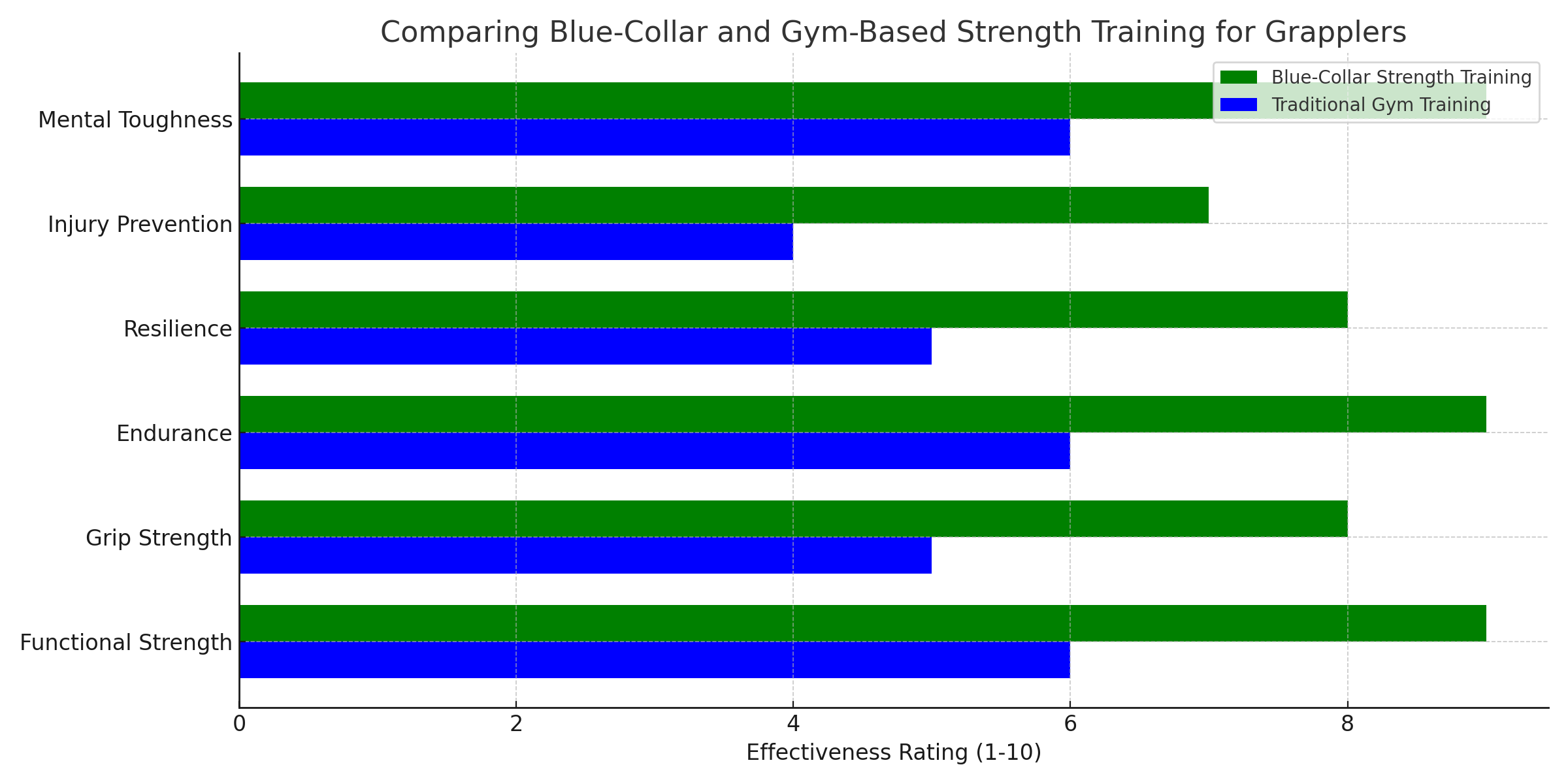
Building Functional Strength: What Grapplers Can Learn from Blue-Collar Workers
Imagine stepping onto the mat with the kind of strength that feels unshakable, the kind that doesn't just come from lifting weights but from real-world, practical power. This isn't about bulging biceps or chiseled abs; it's about the kind of strength that laborers develop through years of hard, physical work. Let's delve into how grapplers can harness this "working man strength" to elevate their game.
The Blueprint of Blue-Collar Strength
1. Strength Beyond the Gym: Real-World Applications
Blue-collar workers engage daily with tasks that require lifting, carrying, and maneuvering awkward, heavy objects. Unlike the predictable movements in a gym, their work involves dynamic, ever-changing challenges that build a unique kind of functional strength.
"Odd objects can be effectively mixed in with free weights to develop you into a more explosive, tougher athlete." — Zach Even-Esh, Strength Coach
Research Insight: Training with odd objects can enhance total body strength and grip strength, crucial for grappling success. Source
2. Endurance Carved from Long Hours
Long shifts performing physical labor don't just build muscle; they cultivate endurance. Grapplers can benefit from this by extending their training sessions to include sustained, moderate-intensity drills that push the boundaries of their stamina.
"The farmer’s walk is a resistance-training exercise where a heavy object is lifted and carried for an extended period. It exercises almost every muscle group, improving cardio health, endurance, and strength." — Healthline
Statistic: The farmer's walk engages multiple muscle groups, enhancing cardiovascular health and overall endurance. Source
3. Diverse Movements for a Versatile Body
Manual laborers rarely perform the same movement repeatedly; their tasks require adaptability. Grapplers face similar unpredictability on the mat, making it essential to train in varied movement patterns.
"Lifting something that is un-balanced will do wonders for your strength and also your ability to lift things in daily life." — Matthew Palfrey, Strength Coach
Expert Insight: Incorporating odd object lifting into training regimens can significantly enhance functional strength and adaptability. Source
Translating Labor Strength to Grappling Prowess
1. Functional Strength for Effective Grappling
Grappling demands more than isolated muscle strength; it requires coordinated, full-body power to control and subdue an opponent. Functional strength training mirrors the compound movements needed in matches.
"Functional strength training emphasizes exercises that mimic everyday movements, which enhances overall strength, balance, coordination, and flexibility." — Verywell Health
Scientific Insight: Functional strength training improves overall strength and reduces injury risk by engaging multiple muscle groups in practical movements. Source
2. Building Resilience Against Injury
The varied and unpredictable nature of manual labor builds resilience against injuries. Grapplers can develop similar resilience by incorporating unstable and variable resistance training into their routines.
"Strongman and odd object training prevents injuries in a number of ways. Obviously, the strength benefits are a plus." — Doyle Health & Performance
Expert Insight: Odd object training enhances injury prevention by developing stabilizing muscles and improving overall body coordination.

This visual highlights how blue-collar-inspired training outperforms traditional gym routines in key grappling metrics like functional strength, resilience, and mental toughness.
FAQ: Functional Strength for Grapplers
1. Can I mix conventional lifting with odd object training?
Absolutely! Many coaches recommend blending both to build foundational power and enhance real-world functionality.
2. How often should I train with odd objects?
Start with 1–2 sessions per week. Gradually increase frequency as your body adapts.
3. Is this kind of training safe?
When done with proper form and progressive loading, it's just as safe as traditional weightlifting—and may even prevent injury by building stabilizer muscles.
Action Steps: Get to Work
- Start Small: Add one odd object movement to your current routine, like sandbag carries or tire flips.
- Build Circuits: Create 3–5 movement circuits using a mix of loaded carries, swings, slams, and flips.
- Track Your Endurance: Record how long you can sustain high-effort circuits, then aim to improve weekly.
- Test Grip Weekly: Use fat grip tools, towel pull-ups, or farmer's carries to test your hold and track progress.
- Stay Consistent: Incorporate these methods 2–3 times per week for optimal results.
- Focus on Recovery: These sessions are taxing. Prioritize sleep, hydration, and mobility work.
Conclusion: Strength That Works When It Matters
Blue-collar strength isn’t fancy—but it works. For grapplers, it means becoming tougher, more durable, and more capable on the mat. You’ll move better, recover faster, and outlast your opponents with real-world power that doesn't quit when you're tired.
So, ditch the polished machines and pristine gym floors once in a while. Pick up something awkward, heavy, and unforgiving—and build the kind of strength that lasts a lifetime.
💬 Join the Movement
Have you tried blue-collar-inspired training? Share your experience in the comments or tag us with your favorite odd object workouts. Know someone who needs more functional strength? Send this article their way!




